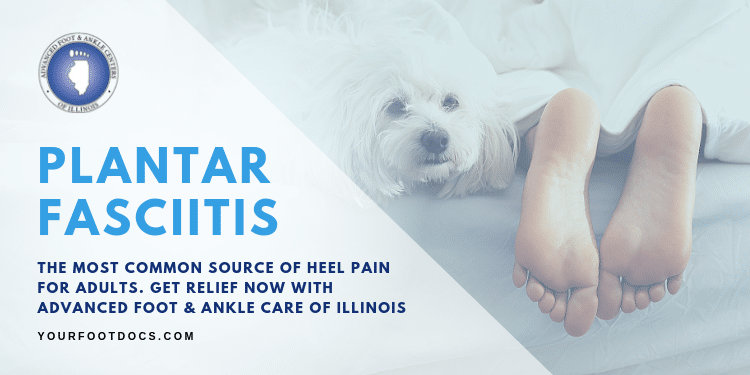Understanding the Most Common Heel Pain: Plantar Fasciitis
At all eight offices for our Chicagoland podiatry practice, we provide first-class treatment to help you overcome foot and ankle conditions and injuries. No matter what is causing you pain or difficulty in a lower limb, we look forward to creating a customized treatment plan to help you get back to your favorite activities.
Of course, just because we treat so many different foot problems doesn’t mean they are all equally as common. In fact, there is one source of heel pain that tends to be more prominent than any other – plantar fasciitis.
There’s a decent chance you are already familiar with this condition. For the benefit of those who aren’t, though, let’s take a real quick look at it. In doing so, we’ll cover some of the signs that will help you recognize a case of plantar fasciitis.
To best understand this condition, it can be helpful to know a bit about the anatomy of your heel.
How Heel Anatomy Relates to Heel Pain
The heel bone is known as the calcaneus, and it sits at the back of the foot, underneath the talus bone. There are two very important tissues that connect to the calcaneus – your Achilles tendon and plantar fascia.
Now, there are certainly issues that can arise on account of the Achilles tendon, but—as you might expect—plantar fasciitis is an injury to the plantar fascia.
So what is a fascia, and what specifically is the plantar fascia?
Well, a fascia is a thin sheath of fibrous connective tissue that encloses a muscle, group of muscles, or organ. The plantar fascia, specifically, bridges the rearfoot to the forefoot. This fibrous tissue runs along the bottom of the foot and supports the arch. In doing so, it is a bit like the string you pull back on bow before letting an arrow fly.
Plantar fasciitis is a very common overuse injury caused when the plantar fascia is subjected to excessive stress. The extra forces cause tiny tears in the tissue, and repeated stretching and tearing results in irritation, inflammation, and pain.
As we look at the symptoms of the condition, the most easily identified sign of plantar fasciitis is an intense, stabbing pain accompanying the first steps following extended periods of rest. This pain is felt in the bottom of the heel, and is often quite pronounced in the morning (after a night’s sleep).
The heel pain will usually subside in time as you move around, but it does return again after any additional periods of rest or time spent standing in one spot. This is explained by the fact that the body works to repair the fascia during those times of rest, but the subsequent steps rip the tears back open.
Beneficial Stretches to Treat and Prevent Plantar Fasciitis
There are stretching exercises that can not only alleviate the pain you encounter with this condition, but also prevent it from happening in the first place. Some of the better ones include:
- Achilles Tendon Stretch – Stand approximately a foot and a half in front of a wall with your hands on it. Place your left foot behind the right one so the toes touch the heel. Keeping your back leg straight, bend your front knee until you feel the stretch in your lower left leg. Hold for 10 seconds and then switch legs. Repeat two more times.
- Plantar Fascia Stretch – Sit barefoot in a chair and place your foot over your knee. Using the hand on the same side as your foot, gently pull back on your toes until you feel a good stretch along the bottom of your foot. Hold for 10 seconds and then switch feet. Repeat two more times.
- Towel Pulls – Place a towel on the floor and grab it with your toes and pull the towel towards you, then switch feet. Repeat 10 times.
Nonsurgical Treatment Options
Stretching exercises are a great way to start—and may turn out to be all the care you need—but it’s certainly possible that you will require additional treatment.
Other components we may include in your plantar fasciitis treatment plan, include:
- Rest. Taking time away from high-impact activities or, even better, replacing them with low-impact ones (cycling, swimming) will better allow your body to repair the damaged tissue.
- Ice. An appropriate icing regimen will both relieve inflammation in the fascia and reduce pain.
- Medication. We may recommend or prescribe certain pain relievers (including ibuprofen and naproxen), or use corticosteroid injections to provide relief.
- Orthotic devices. Whether we prescribe custom orthotics or recommend certain heel cups or cushioning inserts, these devices can more equitably distribute pressure and take it away from your fascia.
- Laser therapy. One of the advanced treatment options we’re proud to offer is MLS laser therapy. With this therapy, energy from concentrated light beams travel down to an injury site and enhance natural healing properties. (Please note: This treatment is currently only available at our Joliet and Schaumburg offices.)
Learn more about MLS laser therapy!
- Aquaroll. This is an advanced therapy—one used by professional athletes—where patients submerge affected feet in warm water containing tens of thousands glass beads, which is rotated to create a compressive and vibratory effect. (Please note: This treatment is currently only available at our Joliet office.)
Learn more about Aquaroll therapy!
Preventing Heel Pain
It is basically impossible to eliminate all risk of any injury, including ones like plantar fasciitis. Now, with that being said, you can take some measures to at least lower the odds. These include things like:
- Stretch every day. We already listed some stretches you can use, so take just a couple of minutes (about 10-15 should do the trick) to make sure you are stretching the connective tissues and muscles most responsible for heel pain. Target your Achilles tendons, plantar fasciae, and calf muscles for optimal results.
- Ease into new activities. When you start a new exercise program or sign up for a rec sports league, make sure you prepare your body. This means starting at low levels of intensity and duration, and then gradually ramping them up as your body acclimates to the new routine.
- Wear proper footwear. Always make sure you’re wearing the right kinds of shoes for any physical activity you perform. They also need to fit properly and be well-constructed. Your best options will feature robust arch support, solid heel counters, and adequate cushioning under the heel.
- Maintain a healthy bodyweight. There are many reasons to watch your weight and shed excess pounds, and you can add “reduce your risk of heel pain” to the list. Less bodyweight means less pressure on your feet and heels!
- Don’t over-train. Exercise is obviously important for your body, but too much of a good thing can become a bad thing. Instead of running long distances six days a week, cross-train by swapping out some running sessions with low-impact exercises like swimming, cycling, or yoga.
We hope these preventive efforts will lower your injury risk, but come see us if you develop heel pain!
If you would like additional information on this common overuse injury—or you are experiencing the sharp pain it causes and would like professional treatment—contact Advanced Foot & Ankle Centers of Illinois by calling any of our eight offices located in the greater Chicago (and southern Wisconsin) area. To help serve you better, we also have an online form that you can fill out to connect with us right now!


